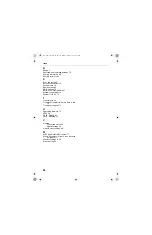
79
phone lines or radio waves to transmit data between the
PCs. LANs include home and small-business networks.
Mbps
Megabits per second, a measure of data transmission
speed.
NAT
Network Address Translation. A service that translates
your local private IP addresses to a public Internet
address so your privately addressed network can
connect to the public Internet. NAT simplifies network
setup and adds a measure of security to your network
because your private network addresses are never seen
on the Internet.
Peer-to-Peer
Mode
See Ad Hoc Mode.
Profiles
(Network
Profiles)
A collection of software settings and network
identification information that is unique for each network.
Protocols
(Network
Protocols)
Define the rules for all aspects of data communication,
just like a written language uses rules for spelling,
sentence structure, and so on. Protocols describe the
way data is organized, transmitted and received. The
TCP/IP protocol is one of the most common.
Resources
(Network
resources)
Software or hardware shared by the users of a network.
Resources can include software applications,
documents, digital pictures and music, games, numeric
data, and devices such as printers, modems and disk
drives.
Roaming
Moving seamlessly from one access point coverage area
to another with no loss in connectivity.
SSID
Service Set Identifier. To communicate with each other,
all wireless devices on the same network must use the
same SSID. The SSID allows two or more wireless
user_guide_rg1210.book Page 79 Monday, April 22, 2002 2:20 PM














































